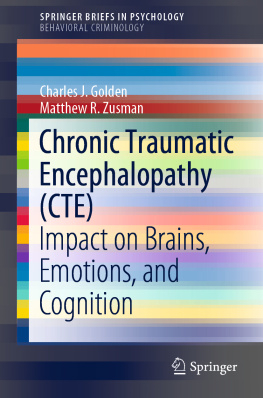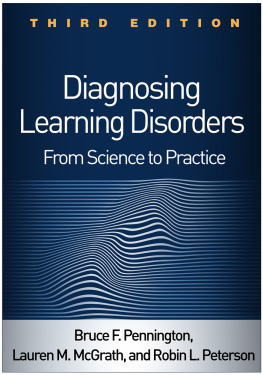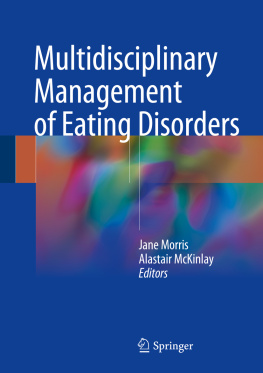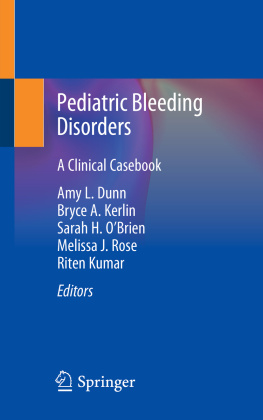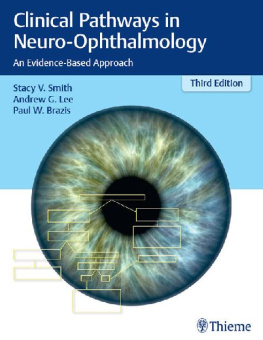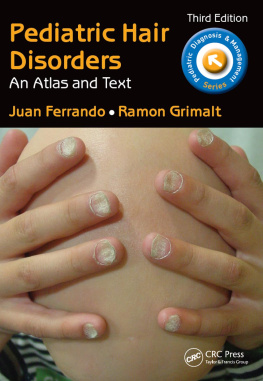
Learning Disabilities
Learning Disabilities
Charles J. Golden, Lisa K. Lashley, Jared S. Link, Matthew Zusman, Maya Pinjala, Christopher Tirado, and Amber Deckard

Learning Disabilities
Copyright Momentum Press, LLC, 2016.
All rights reserved. No part of this publication may be reproduced, stored in a retrieval system, or transmitted in any form or by any meanselectronic, mechanical, photocopy, recording, or any other except for brief quotations, not to exceed 400 words, without the prior permission of the publisher.
First published in 2016 by
Momentum Press, LLC
222 East 46th Street, New York, NY 10017
www.momentumpress.net
ISBN-13: 978-1-60650-833-6 (paperback)
ISBN-13: 978-1-60650-834-3 (e-book)
Momentum Press Child Clinical Psychology Nuts and Bolts Collection
Cover and interior design by Exeter Premedia Services Private Ltd.,
Chennai, India
First edition: 2016
10 9 8 7 6 5 4 3 2 1
Printed in the United States of America.
Abstract
Clinicians within the fields of neuropsychology and school psychology may find this text to be a useful guide in understanding and assessing the disparate learning disorders. This resource reviews the extant literature regarding the current status of diagnosis, conceptualization, and evaluative methods of reading, mathematics, writing, and nonverbal learning disorders. Interventions will be elucidated regarding the remediation of the various subtypes of learning disorders. This book is specifically tailored to aid busy clinicians and students-in-training in accruing the clinical acumen pertinent to the assessment of learning disorders. Case studies are included that will give insight into the types of cases and profiles clinicians will often come across in practice.
Keywords
disorder of written expression, evaluation and assessment of learning disorder, learning disorder, learning disorder diagnosis, math disorder, neuropsychological assessment of learning disorder, nonverbal learning disorder, reading disorder, specific learning disorder
With the passing of the Education forAll Handicapped Children Act, now called the Individuals with Disabilities Education Act 2004 (IDEA), by Congress in 1975, those experiencing trouble in various skills necessary for academic success were finally provided with the opportunity to receive free appropriate public education (Cortiella and Horowitz ). Once individuals have been identified as having a disability that affects their performance in schools, colleges, or the workplace, accommodations can be made to help them succeed.
Prevalence rates of LDs have varied depending on the definition and method of which cases are verified. Current rates estimate that approximately 5 percent of American public school students have been classified as having an LD as defined under IDEA. The lifetime prevalence of LDs in children in the United States has been estimated to be 9.7 percent, and has been shown to have a higher prevalence in those with special health care needs (27.8 percent; Altarac and Saroha ), approximately 19 percent of those diagnosed with an LD drop out of school, and Blacks, Hispanics, and males are over-represented in the LD category. In addition, it has been reported that there is a higher incidence of LDs in children and adolescents that are at an economic disadvantage, suffer comorbid psychiatric and health-related conditions, and live in foster care, according to investigations carried out by the National Council on Disability.
Currently, IDEA utilizes the term specific learning disability (SLD) and defines this as
a disorder in one or more of the basic psychological processes involved in understanding or in using language, spoken or written, which disorder may manifest itself in the imperfect ability to listen, think, speak, read, write, spell, or do mathematical calculations. Such term includes such conditions as perceptual disabilities, brain injury, minimal brain dysfunction, dyslexia, and developmental aphasia. Such term does not include a learning problem that is primarily the result of visual, hearing or motor abilities, of mental retardation, of emotional disturbance, or of environmental, cultural, or economic disadvantage. (20 U.S.C. 1401)
Similar definitions have been described in the Diagnostic and Statistical Manual of Mental Disorders, Fourth Edition, Text Revised (DSMIV-TR; APA [American Psychiatric Association] 2000), and the recently released Diagnostic and Statistical Manual of Mental Disorders, Fifth Edition (DSM-5; APA 2013). Each of these definitions have differences as well as similarities, and given that many institutions have not officially adopted the DSM-5, both will be discussed below.
The DSM-IV-TR defines LDs as occurring when achievement level on standardized tests in reading, mathematics, or written expression is significantly below that which is expected given an individuals age, education level, and measured intelligence. This distinction is made via a discrepancy-based model in which there must be at least a standard deviation difference of 1.5 to 2 between the achievement level in a particular area and their overall IQ (APA ). The DSM-IV-TR utilizes different methods of classifying specific learning difficulties through distinctive criteria that must be met in order for a diagnosis of an LD to be made. These particular diagnoses include: reading disorder, mathematics disorder, and disorder of written expression.
Reading Disorder
According to the DSM-IV-TR (APA ). The DSM-IV criteria for reading disorder include: (1) Reading achievement, as measured by individually administered standardized tests of reading accuracy or comprehension, is substantially below their expected level, based on the persons chronological age, measured intelligence, and age-appropriate education; (2) the disturbance above significantly interferes with academic achievement or activities of daily living that require reading skills; and (3) if a sensory deficit is present, the reading difficulties are in excess of those usually associated with it. If a sensory deficit is the sole cause of the problem, that would be the appropriate diagnosis.
Mathematics Disorder
The prevalence rate of mathematics disorder or developmental dyscalculia has been estimated to be in the approximate range of 3 to 6.5 percent in a variety of countries including the United States, Germany, India, and Israel (Badian ). Such psychological factors can contribute to poor performance in school and can even lead to misdiagnosis.
Recent estimates have indicated that the rate of mathematics disorder diagnosis is approximately similar between genders (Shalev ).
DSM-IV-TR criteria for mathematics disorder include: (1) Mathematics achievement in the area of mathematics on standardized tests, and is deemed to be significantly below what would be expected for the individuals age, intelligence, and education level using a criteria of a 1.5 standard deviation impairment when compared to expected levels. (2) The problems include such issues as difficulties in writing or printing numbers, counting, adding and subtracting, working with mathematical signs, or learning names that include numbers. (3) Problems also include difficulties in performing calculations, comprehending word problems, and an inability to grasp mathematical information. (4) Other impairments may be seen in various areas including linguistic skills (e.g., understanding or naming mathematical terms, operations, or concepts), perceptual skills (e.g., recognizing or reading numerical symbols or arithmetic signs, and clustering objects into groups), attention skills (e.g., copying numbers or figures correctly, remembering to add in carried numbers, and observing operational signs), and mathematical skills (e.g., following sequences of mathematical steps, counting objects and learning multiplication tables). Furthermore, this deficit must interfere with their academic achievement and/or other activities that involve the need or use of mathematical ability (e.g., calculating change or tip, creating a budget, paying taxes, etc.). (5) The mathematics problem must significantly interfere with academic achievement or activities that require mathematical ability (such as measuring or calculations in the workplace. (6) If a sensory deficit is present, the problems must exceed those expected by that deficit (e.g., a blind person would not be expected to read printed mathematical symptoms). If a sensory deficit is the complete cause of the problem, that deficit (e.g., blindness) is the proper diagnosis.
Next page

